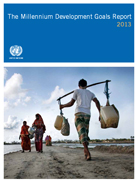
“The Millennium Development Goals have been the most successful global anti-poverty push in history,” Mr. Ban said. “The MDGs have proven that focused global development objectives can make a profound difference.” The eight goals were agreed by all countries as an outgrowth of the UN Millennium Summit in 2000.
With millions of people’s lives improved by already meeting targets on reducing poverty, increasing access to safe water, improving the lives of slum dwellers and achieving gender parity in primary schools, the report says remarkable progress in other areas means more MDGs targets can be achieved by 2015.
Millions of lives saved
According to the report, big gains have been made in health. Between 2000 and 2010, mortality rates from malaria fell by more than 25 per cent globally, and an estimated 1.1 million deaths were averted. Death rates from tuberculosis at the global level and in several regions could be halved by 2015, compared to 1990 levels. Between 1995 and 2011, a cumulative total of 51 million tuberculosis patients were successfully treated, saving 20 million lives.
The report notes that while new HIV infections are declining, an estimated 34 million people were living with HIV in 2011. At the end of 2011, 8 million people were receiving antiretroviral therapy for HIV or AIDS in developing regions, and the MDG target of universal access to antiretroviral therapy remains reachable by 2015 if current trends continue, the report states.
The target of halving the percentage of people suffering from hunger by 2015 is within reach, the report says. The proportion of undernourished people worldwide decreased from 23 per cent in 1990-1992 to 15 per cent in 2010-2012.
Accelerated action needed
Worldwide, the mortality rate for children under five dropped by 41 per cent – from 87 deaths per 1,000 live births in 1990 to 51 in 2011, which means 14,000 fewer child deaths per day. Increasingly, child deaths are concentrated in the poorest regions, and in the first month of life.
Globally, the maternal mortality ratio declined by 47 per cent over the last two decades, from 400 maternal deaths per 100,000 live births to 210 between 1990 and 2010. The report says meeting the MDG target of reducing the ratio by three-quarters will require accelerated interventions and stronger political backing for women and children.
Between 2000 and 2011, the number of children out of school declined by almost half – from 102 million to 57 million, but the report says too many children are still denied their right to primary education. From 1990 to 2011, 1.9 billion people gained access to a latrine, flush toilet or other improved sanitation facility, but 2.5 billion still lack improved sanitation facilities. The report also notes that the planet’s resource base is in serious decline, with ongoing losses of forests, species and fish stocks, in a world already experiencing the impacts of climate change.
Uneven progress
Global attention needs to focus on disparities, the report recommends. Progress towards the eight MDGs has been uneven not only among regions and countries, but also between population groups within countries. People living in poverty or in rural areas remain at an unfair disadvantage. In 2011, only 53 per cent of births in rural areas were attended by skilled health personnel, versus 84 per cent in urban areas. Eighty-three per cent of the population without access to an improved drinking water source live in rural communities.
Aid money falling to the poorest countries
Achievement of the Goals is affected by less aid money overall, with the poorest countries most adversely affected, the report notes. In 2012, net aid disbursements from developed to developing countries totalled $126 billion. This represents a 4 per cent drop in real terms compared to 2011, which was 2 per cent below 2010 levels. The decline affected least developed countries the most. In 2012, bilateral official development assistance to these countries fell by 13 per cent, to about $26 billion. However, the report shows that lower debt burdens and improved access to trade are benefiting developing countries.
MDGs and the Post-2015 Development Agenda
The United Nations is working with governments, civil society and other partners to build on the momentum generated by the MDGs, to craft an ambitious, yet realistic, agenda for the period after the MDG target date at the end of 2015. The report says a successful conclusion to the MDGs will be an important building block for a successor development agenda, and that volumes of experience and lessons learned from the MDGs will benefit prospects for continued progress.
“Through accelerated action, the world can achieve the MDGs and generate momentum for an ambitious and inspiring post-2015 development framework,” Mr. Ban said. “Now is the time to step up our efforts to build a more just, secure and sustainable future for all.”
The Millennium Development Goals Report, an annual assessment of global and regional progress towards the Goals, reflects the most comprehensive, up-to-date data compiled by over 27 UN and international agencies and is produced by the UN Department of Economic and Social Affairs. A complete set of the data used to prepare the report is available at mdgs.un.org
